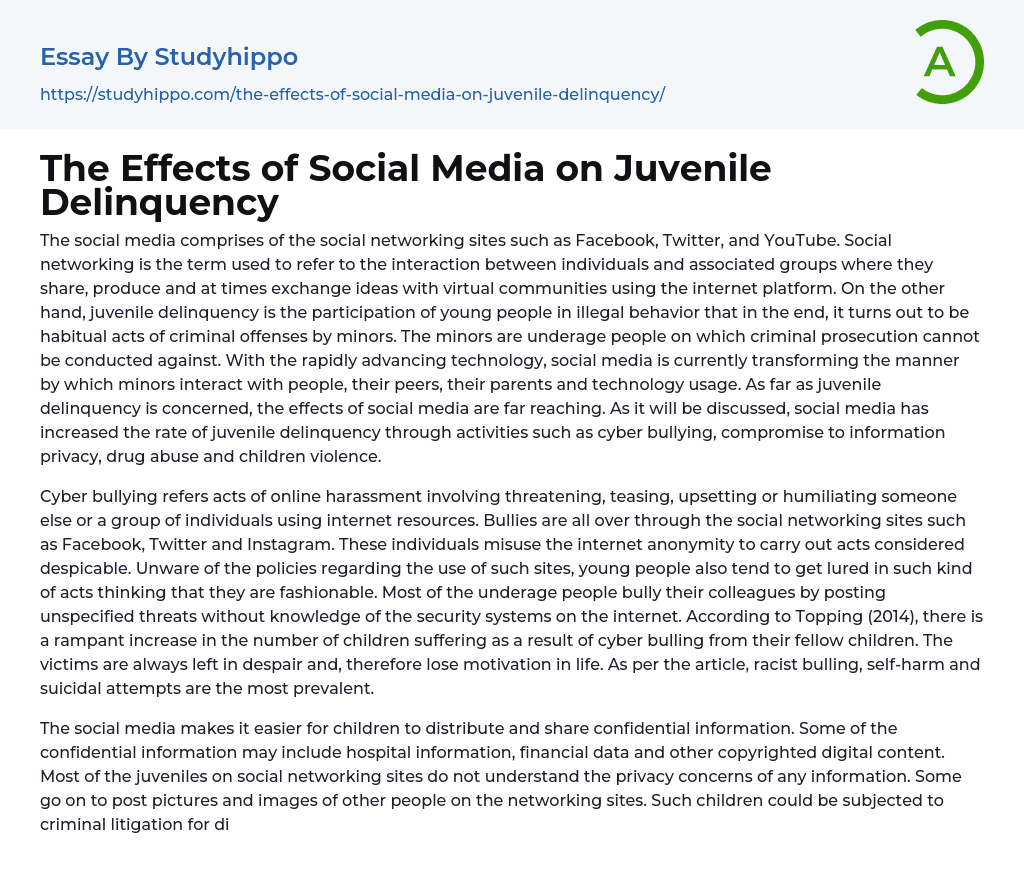

The Effects of Social Media on Juvenile Delinquency Essay Example
The social media comprises of the social networking sites such as Facebook, Twitter, and YouTube. Social networking is the term used to refer to the interaction between individuals and associated groups where they share, produce and at times exchange ideas with virtual communities using the internet platform. On the other hand, juvenile delinquency is the participation of young people in illegal behavior that in the end, it turns out to be habitual acts of criminal offenses by minors. The minors are underage people on which criminal prosecution cannot be conducted against. With the rapidly advancing technology, social media is currently transforming the manner by which minors interact with people, their peers, their parents and technology usage. As far as juvenile delinquency is concerned, the effects of social media are far reaching. As it will be discussed, social media has increased
...the rate of juvenile delinquency through activities such as cyber bullying, compromise to information privacy, drug abuse and children violence.
Cyber bullying refers acts of online harassment involving threatening, teasing, upsetting or humiliating someone else or a group of individuals using internet resources. Bullies are all over through the social networking sites such as Facebook, Twitter and Instagram. These individuals misuse the internet anonymity to carry out acts considered despicable. Unware of the policies regarding the use of such sites, young people also tend to get lured in such kind of acts thinking that they are fashionable. Most of the underage people bully their colleagues by posting unspecified threats without knowledge of the security systems on the internet. According to Topping (2014), there is a rampant increase in the number of children suffering as a result
of cyber bulling from their fellow children. The victims are always left in despair and, therefore lose motivation in life. As per the article, racist bulling, self-harm and suicidal attempts are the most prevalent.
The social media makes it easier for children to distribute and share confidential information. Some of the confidential information may include hospital information, financial data and other copyrighted digital content. Most of the juveniles on social networking sites do not understand the privacy concerns of any information. Some go on to post pictures and images of other people on the networking sites. Such children could be subjected to criminal litigation for distributing information without the owner’s consent. Distributing and sharing the copyrighted content such as music, videos and software programs is unlawful and such acts could render children as juvenile delinquents (Hg.org, 2016). In some extreme cases children end up posting images and video clips considered explicit by the law enforcing agencies. Images and videos detailing bodies of massacred people, examination papers and nude prominent personnel are prohibited in most countries such kind of offenses only tend to subject juveniles to criminal litigation without their Knowledge.
Studies indicate that social media greatly influences children drug abuse. Most underage children fall victims of social media peer pressure and adopt the lifestyles of their colleagues who greatly abuse drugs. Many pictures and videos detailing underage children using illegal drugs are prevalent on social media. According to the National Teen Survey of 2011, most children on social networking sites have a high likelihood to be smoking, drinking or use other drugs. According to the findings, most of the interviewed children who are drug addicts admitted to
have acquired the habit through social media influence. The report states that most teens spending much time on social media are 2 times likely to be using Marijuana, 3 times likely to be taking alcohol and 5 times likelier to be tobacco smokers. Most of these teens fall victims thinking that such behavior is fashionable just as they interpret the information circulated over the social media (NCASA, 2016).
The social media accelerates the rate of juvenile delinquency by promoting children’s violent behavior. Violent images and video clips circulated through the social media have varying time effects on arousal of emotions and thoughts that cause aggressive behavior or arrogance in young children. Images propagated in form of video games portray players maiming, killing and creating all kinds of havoc. The games connect directly to the mind of the child because they are always the ones in control of the game. According to Meeting & Meeting (2014), the social media networks are the most notable platforms that perpetuate youth violence and aggression. According to the article, even gangs use the social media to make threats, insight their rivals, and promote violence while recruiting young people. Fight compilation videos are new trends on social media that trigger violent emotions in underage youth especially boys. The meta-analysis studies on social media unhealthy effects indicate that youth coming across media violence on regular basis tend to exhibit antisocial behaviors beginning with imitations, acceptance of the behavior and eventually develop increased feelings of hostility and criminal offenses (Meeting & Meeting, 2014).
In conclusion, the social media perpetuates juvenile delinquency at a greater extend. The youth can either use the social media as a
platform to carry out illegal activities or use the media as the source of conviction to carry out more physical criminal activities. While using the social media as a platform, the juveniles engage in bullying activities and compromising information privacy. On the other, while using the social media as a source of conviction, the juveniles are influenced to indulge in drug abuses and other violently aggressive behavior that eventually turns out to promote juvenile delinquency.
References
- Topping, A. (2014). Cyberbullying: increasing number of children suffering, says ChildLine. the Guardian. Retrieved 31 March 2016, from http://www.theguardian.com/society/2014/jan/08/cyberbullying-more-children-affected- childline
- Hg.org. (2016). Retrieved 31 March 2016, from http://www.hg.org/computer-crime.html
- NCASA. (2016). The National Center on Addiction and Substance Abuse. Retrieved 31 March 2016, from http://www.centeronaddiction.org/newsroom/press-releases/2011-national- teen-survey-finds
- Meeting, Y., & Meeting, Y. (2014). Does Social Media Perpetuate Youth Violence? - Michigan Youth Violence Prevention Center. Michigan Youth Violence Prevention Center. Retrieved 31 March 2016, from http://yvpc.sph.umich.edu/social-media-perpetuate- youth-violence



